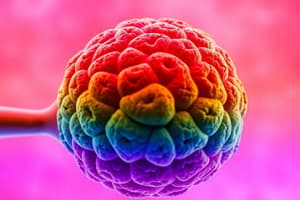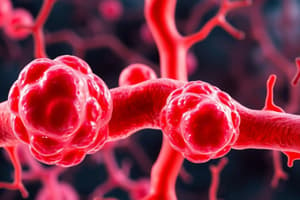Podcast
Questions and Answers
What characteristic is typical of malignant tumors?
What characteristic is typical of malignant tumors?
- Have a higher tendency to metastasize (correct)
- Low mitotic activity
- Usually grow back after removal
- Do not invade nearby tissues
Which of the following features is associated with benign tumors?
Which of the following features is associated with benign tumors?
- Can form secondary tumors
- Exhibit rampant growth
- Invasion to adjacent tissues
- Usually not life threatening when removed (correct)
Which statement about carcinoma is correct?
Which statement about carcinoma is correct?
- It generally grows faster than benign tumors. (correct)
- It typically arises from mesenchymal tissue.
- It is more common in children than in adults.
- It often metastasizes through the lymphatic system.
Which type of tumor is defined as having the potential to become malignant over time?
Which type of tumor is defined as having the potential to become malignant over time?
What is a common method of metastasis for malignant tumors?
What is a common method of metastasis for malignant tumors?
What is an essential trait of metastatic tumors?
What is an essential trait of metastatic tumors?
Which type of tumor typically presents with slower growth and lower chances of metastasizing?
Which type of tumor typically presents with slower growth and lower chances of metastasizing?
Which characteristic is NOT associated with malignant tumors?
Which characteristic is NOT associated with malignant tumors?
What is the primary recommendation for reducing health risks related to alcohol?
What is the primary recommendation for reducing health risks related to alcohol?
What is the recommended age for women to start having mammograms for breast screening?
What is the recommended age for women to start having mammograms for breast screening?
Which of the following is NOT true about breast ultrasound?
Which of the following is NOT true about breast ultrasound?
What is the purpose of the Papanicolaou test in women aged 21 to 29?
What is the purpose of the Papanicolaou test in women aged 21 to 29?
Which of the following is a primary prevention strategy mentioned?
Which of the following is a primary prevention strategy mentioned?
For which age group is the Papanicolaou test recommended every three years?
For which age group is the Papanicolaou test recommended every three years?
What is an inappropriate method for preventing health issues related to sun exposure?
What is an inappropriate method for preventing health issues related to sun exposure?
What diagnostic test is primarily used to detect DNA of human papillomaviruses (HPV) in women aged 30 to 65?
What diagnostic test is primarily used to detect DNA of human papillomaviruses (HPV) in women aged 30 to 65?
Which monoclonal antibody specifically targets Vascular Endothelial Growth Factor (VEGF)?
Which monoclonal antibody specifically targets Vascular Endothelial Growth Factor (VEGF)?
What is the primary treatment approach of immunotherapy in cancer management?
What is the primary treatment approach of immunotherapy in cancer management?
Which type of breast cancer primarily originates in the ducts and lobes?
Which type of breast cancer primarily originates in the ducts and lobes?
In the context of breast cancer, what does the 'T' in tumor classification indicate?
In the context of breast cancer, what does the 'T' in tumor classification indicate?
Which marker is commonly found on the cell membrane of lymphocytes and targeted by certain therapies?
Which marker is commonly found on the cell membrane of lymphocytes and targeted by certain therapies?
Which statistic reflects the breast cancer incidence rate among Filipino women by age 75?
Which statistic reflects the breast cancer incidence rate among Filipino women by age 75?
What growth factor protein does Trastuzumab primarily target?
What growth factor protein does Trastuzumab primarily target?
Which of the following is NOT a characteristic of breast cancer as mentioned?
Which of the following is NOT a characteristic of breast cancer as mentioned?
What specific requirement is necessary before taking a colorectal guaiac test?
What specific requirement is necessary before taking a colorectal guaiac test?
What is a potential long-term consequence of infection with certain types of HPV?
What is a potential long-term consequence of infection with certain types of HPV?
What does a colonoscopy allow healthcare providers to do?
What does a colonoscopy allow healthcare providers to do?
At what age is it recommended for men and women to undergo a colonoscopy?
At what age is it recommended for men and women to undergo a colonoscopy?
What is the primary purpose of the diagnosis of cancer?
What is the primary purpose of the diagnosis of cancer?
What is evaluated to assess possible disease metastasis during cancer diagnosis?
What is evaluated to assess possible disease metastasis during cancer diagnosis?
During the cancer diagnosis process, what type of analysis is performed on tissue and cells?
During the cancer diagnosis process, what type of analysis is performed on tissue and cells?
Which of the following describes a function of the flexible camera used in colonoscopy?
Which of the following describes a function of the flexible camera used in colonoscopy?
What happens during the promotion stage of carcinogenesis?
What happens during the promotion stage of carcinogenesis?
Which gene is frequently mutated and is known as the 'guardian of the genome'?
Which gene is frequently mutated and is known as the 'guardian of the genome'?
What is the primary mechanism of lymphatic spread in cancer metastasis?
What is the primary mechanism of lymphatic spread in cancer metastasis?
What characteristic change occurs during the progression of cancer?
What characteristic change occurs during the progression of cancer?
How do tumor suppressor genes typically function in healthy cells?
How do tumor suppressor genes typically function in healthy cells?
Which substance is known for promoting tumor angiogenesis?
Which substance is known for promoting tumor angiogenesis?
What role do viruses play in the etiology of cancer?
What role do viruses play in the etiology of cancer?
Which of the following best describes the initiation step in the carcinogenesis process?
Which of the following best describes the initiation step in the carcinogenesis process?
What effect do promoting agents have on proto-oncogenes?
What effect do promoting agents have on proto-oncogenes?
Which physical agent is commonly associated with carcinogenesis?
Which physical agent is commonly associated with carcinogenesis?
Flashcards are hidden until you start studying
Study Notes
Benign Tumors
- Do not spread to nearby tissues
- Can be removed and usually do not grow back
- Can be large and cause serious symptoms
- Can be life-threatening in the brain
Malignant Tumors
- Characterized by more than 2 abnormal cells with abnormal chromosomes
- Invade neighboring tissues and metastasize
- Lack contact inhibition
- Do not form intracellular junctions
- Grow rapidly
Tumors with Borderline Behavior
- Not yet invasive but could become malignant
- Also known as carcinoma in situ
- Confined to the origination layer of cells without invading deep tissues
Metastatic Tumors
- Malignant cancer cells spread from the original tumor to other parts of the body, forming new tumors
- Secondary tumors comprise the same type of cancer cells as the primary tumor
Carcinogenesis
- A three-step cellular process: initiation, promotion, and progression.
Initiation
- The first step of carcinogenesis where normal cells are exposed to carcinogens, causing DNA damage
- These mutations are usually not significant until the second step.
Promotion
- Repeated exposure to promoting agents causes abnormal or mutant genetic information expression
- Changes proto-oncogenes into oncogenes (genes that cause cancer) turning cellular growth "on"
- Affects tumor suppressor genes by turning them "off," removing the ability to regulate cell growth and proliferation
- Loss of suppressor gene function leads to the loss of the ability to perform apoptosis
- P53 gene alteration can decrease apoptotic signals, decreasing mutant cell death
Progression
- Cellular changes from initiation and promotion exhibit increased malignant behaviors.
- Invades adjacent tissues and metastasizes.
- The process of invasion relies on mechanical pressure from the tumor.
- The tumor destroys surrounding tissues and vascular membranes through destructive enzymes.
Metastasis
- Spread of cancer cells.
- Lymphatic spread is the most common mechanism of metastasis.
- Other methods of metastasis include hematogenous spread, angiogenesis, direct extension, and seeding or diffusion.
Etiology
- Etiology is the study of the causes of diseases.
- Physical agents - radiation, excessive sunlight exposure.
- Chemical agents - tobacco use, drugs, toxic and chemical wastes.
- Viruses and bacteria - these can alter a cell's DNA, causing cancer, for example, HPV infection.
Primary Prevention
- Quit smoking and reduce alcohol consumption.
- Avoid excessive sun exposure.
- Participate in lay forums and support groups.
Secondary Prevention
- Breast cancer: Mammography is the diagnostic test of choice for women over 40.
- Cervical cancer: Between the ages of 21-29, Pap Smear tests are recommended.
- Between the ages of 30-65, testing for Human Papillomavirus (HPV) DNA is performed.
- Colorectal cancer: Guaiac tests detect small amounts of blood in stool.
- A colonoscopy is recommended for men and women over 50.
Diagnostics
- Used to determine the presence and extent of cancer
- Determine possible disease metastasis
- Evaluate body systems and involved organs
- Obtain tissues and cells for analysis, including tumor grade and stage
Treatment Options
- Surgery - removes detectable tumors.
- Radiation - delivers high-energy rays to destroy cancer cells.
- Chemotherapy - uses drugs that destroy rapidly dividing cells.
- Immunotherapy - uses the body's immune system to fight cancer.
- Hormone therapy - uses hormones to target certain cancers.
Breast Cancer
- Often begins as a hard, painless, fixed nodule in the upper outer quadrant of the breast.
- Mostly adenocarcinoma tumors, originating from ducts and lobes.
- The Philippines has the highest incidence of breast cancer in Asia.
- The TNM staging system is used to assess breast cancer:
- T: describes tumor size and location.
- N: describes lymph node involvement.
- M: describes metastasis.
- Common sites of metastasis include: bones, lungs, brain, liver.
Breast Cancer Management
- Diagnosis and treatment are dependent on tumor staging, patient age, and overall health.
- Depending on the stage, surgery, radiation.
- Chemotherapy can be used pre-operatively to reduce tumor size or post-operatively to eliminate remaining cancer cells.
Studying That Suits You
Use AI to generate personalized quizzes and flashcards to suit your learning preferences.





